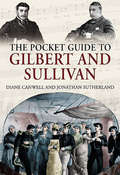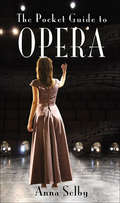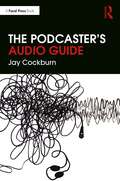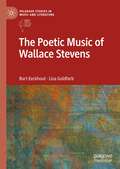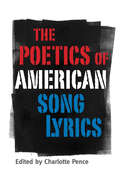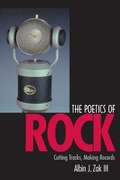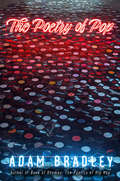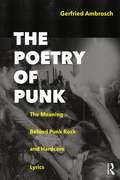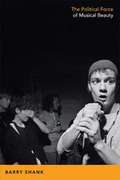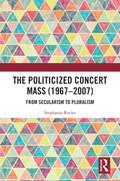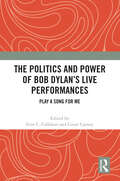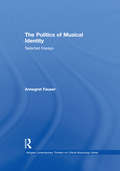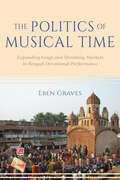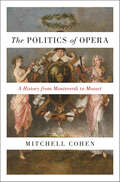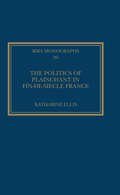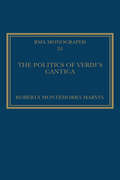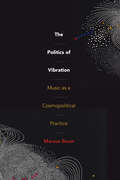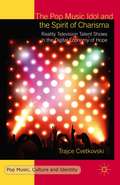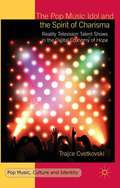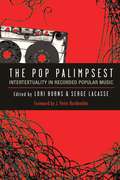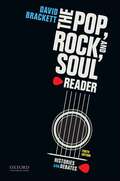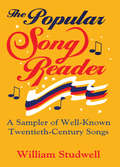- Table View
- List View
The Pocket DJ
by Sarah LewitinnWith more than two thousand songs handpicked and organized by former Spin magazine writer and editor Sarah Lewitinn (aka Ultragrrrl), The Pocket DJ is the ultimate insider's reference guide for selecting music, downloading MP3s, and making all-purpose mixes for every occasion imaginable. Playlists include: Essential genres: with crowd-pleasing dance mixes for indie rockers, headbangers, and hip-hop lovers alike Essential artists: with the best songs by all the greats from the Beatles to Björk Celebrity playlists: featuring Duran Duran, Smahing Pumpkins, Interpol, and Good Charlotte, among others Other playlists: with tunes for working out, making out, or rocking out Plus rock trivia, new music recommendations, DJing tips, Web resources, and more!
The Pocket Guide to Gilbert and Sullivan
by Diane Canwell Jonathan SutherlandLibrettist William S. Gilbert and composer Arthur Sullivan teamed up to make some of the most memorable operettas of all time which still sell out to todays audience at opera houses and theaters around the world and at the cinema. This detailed book explores the themes around each operetta, setting them in the context of the day. It celebrates their biggest stars and what made the characters so memorable and recognizable.
The Pocket Guide to Opera
by Anna SelbyEverything you need to know about opera in one handy guide. Part of our best-selling Pocket Guide series, The Pocket Guide to Opera contains A-Z synopses of operas and biographies of the characters, lyricists and composers. The book features the history of opera, setting it in the context of its day and discussing the influence of world events and influences such as the Freemasons and the composers patrons. With factboxes highlighting surprising, little known and often quirky operatic facts, this fascinating book is a must-buy guide for everyone who loves opera.
The Podcaster's Audio Guide
by Jay CockburnThe Podcaster's Audio Guide is a concise introduction to simple sound engineering techniques for podcasters. This digestible guide explains the basics of audio engineering, from equipment, to recording, editing, mixing and publishing. Suitable for beginners from all backgrounds, including students and hobbyists, as well as professional content producers looking to experiment with podcasts, The Podcaster's Audio Guide is the perfect resource with cheat sheets, starting set-ups and a comprehensive jargon buster.
The Poetic Music of Wallace Stevens (Palgrave Studies in Music and Literature)
by Bart Eeckhout Lisa GoldfarbWallace Stevens’s musicality is so profound that scholars have only begun to grasp his ties to the art of music or the music of his own poetry. In this study, two long-time specialists present a polyphonic composition in which they pursue various interlocking perspectives. Their case studies demonstrate how music as a temporal art form may affect a poetic of ephemerality, sensuous experience, and affective intensification. Such a poetic, they argue, invites flexible interpretations that respond to poetry as an art of textual performance. How did Stevens enact the relation between music and memory? How can we hear his verse as a form of melody-making? What was specific to his ways of recording birdsong? Have we been missing the latent music of Richard Strauss, Gustav Mahler, and Claude Debussy in particular poems? What were the musical poetics he shared with Igor Stravinsky? And how is our experience of the late poetry transformed when we listen to a musical setting by Ned Rorem? The Poetic Music of Wallace Stevens will appeal to experts in the poet’s work, students of Modernism in the arts, and a wider audience fascinated by the dynamics of exchange between music and poetry.
The Poetics of American Song Lyrics (American Made Music Series)
by Charlotte PenceThe Poetics of American Song Lyrics is the first collection of academic essays that regards songs as literature and that identifies intersections between the literary histories of poems and songs. The essays by well-known poets and scholars including Pulitzer Prize winner Claudia Emerson, Peter Guralnick, Adam Bradley, David Kirby, Kevin Young, and many others, locate points of synthesis and separation so as to better understand both genres and their crafts. The essayists share a desire to write on lyrics in a way that moves beyond sociological, historical, and autobiographical approaches and explicates songs in relation to poetics. Unique to this volume, the essays focus not on a single genre but on folk, rap, hip hop, country, rock, indie, soul, and blues. The first section of the book provides a variety of perspectives on the poetic history and techniques within songs and poems, and the second section focuses on a few prominent American songwriters such as Bob Dylan, Bruce Springsteen, and Michael Stipe. Through conversational yet in-depth analyses of songs, the essays discuss sonnet forms, dramatic monologues, Modernism, ballads, blues poems, confessionalism, Language poetry, Keatsian odes, unreliable narrators, personas, poetic sequences, rhythm, rhyme, transcription methods, the writing process, and more. While the strategies of explication differ from essay to essay, the nexus of each piece is an unveiling of the poetic history and poetic techniques within songs.
The Poetics of Rock: Cutting Tracks, Making Records
by Albin J. Zak IIIA fascinating exploration of recording consciousness and compositional process. It examines the crucial roles played by recording technologies in the construction of rock music and shows how songwriters, musicians, engineers, and producers contribute to the creative project.
The Poetry of Pop
by Adam BradleyA trailblazing exploration of the poetic power of popular songs, from Tin Pan Alley to the Beatles to Beyonc#65533; and beyond. Encompassing a century of recorded music, this pathbreaking book reveals the poetic artistry of popular songs. Pop songs are music first. They also comprise the most widely disseminated poetic expression of our time. Adam Bradley traces the song lyric across musical genres from early twentieth-century Delta blues to mid-century rock 'n' roll to today's hits. George and Ira Gershwin's "Fascinating Rhythm. " The Rolling Stones' "(I Can't Get No) Satisfaction. " Rihanna's "Diamonds. " These songs are united in their exacting attention to the craft of language and sound. Bradley shows that pop music is a poetry that must be heard more than read, uncovering the rhythms, rhymes, and metaphors expressed in the singing voice. At once a work of musical interpretation, cultural analysis, literary criticism, and personal storytelling, this book illustrates how words and music come together to produce compelling poetry, often where we least expect it.
The Poetry of Punk: The Meaning Behind Punk Rock and Hardcore Lyrics
by Gerfried AmbroschPunk bands have produced an abundance of poetic texts, some crude, some elaborate, in the form of song lyrics. These lyrics are an ideal means by which to trace the developments and explain the conflicts and schisms that have shaped, and continue to shape, punk culture. They can be described as the community’s collective ‘poetic voice,’ and they come in many different forms. Their themes range from romantic love to emotional distress to radical politics. Some songs are intended to entertain, some to express strong feelings, some to provoke, some to spread awareness, and some to foment unrest. Most have an element of confrontation, of kicking against the pricks. Socially and epistemologically, they play a central role in the scene’s internal discourse, shaping communities and individual identities. The Poetry of Punk is an investigation into the Anglophone punk culture, specifically in the UK and the US, where punk originated in the mid-1970s, its focus being on the song lyrics written and performed by punk rock and hardcore artists.
The Political Force of Musical Beauty
by Barry ShankIn The Political Force of Musical Beauty, Barry Shank shows how musical acts and performances generate their own aesthetic and political force, creating, however fleetingly, a shared sense of the world among otherwise diverse listeners. Rather than focusing on the ways in which music enables the circulation of political messages, he argues that communities grounded in the act and experience of listening can give rise to new political ideas and expression. Analyzing a wide range of "beautiful music" within popular and avant-garde genres--including the Japanese traditions in the music of Takemitsu Toru and Yoko Ono, the drone of the Velvet Underground, and the insistence of hardcore punk and Riot grrrl post-punk--Shank finds that when it fulfills the promise of combining sonic and lyrical differences into a cohesive whole, musical beauty has the power to reorganize the basis of social relations and produce communities that recognize meaningful difference.
The Politicized Concert Mass (1967-2007): From Secularism to Pluralism
by Stephanie RockeSince the transformative 1960s, concert masses have incorporated a range of political and religious views that mirror their socio-cultural context. Those of the long 1960s (c1958-1975) reflect non-conformism and social activism; those of the 1980s, environmentalism; those of the 1990s, universalism; and those of the 2000s, cultural pluralism. Despite utilizing a format with its roots in the Roman Catholic liturgy, many of these politicized concert masses also reflect the increasing religious diversification of Western societies. By introducing non-Catholic and often non-Christian beliefs into masses that also remain respectful of Christian tradition, composers in the later twentieth century have employed the genre to promote a conciliatory way of being that promotes the value of heterogeneity and reinforces the need to protect the diversity of musics, species and spiritualities that enrich life. In combining the political with the religious, the case studies presented pose challenges for both supporters and detractors of the secularization paradigm. Overarchingly, they demonstrate that any binary division that separates life into either the religious or the secular and promotes one over the other denies the complexity of lived experience and constitutes a diminution of what it is to be human.
The Politics and Power of Bob Dylan’s Live Performances: Play a Song for Me
by Erin C Callahan Court CarneyEphemeral by nature, the concert setlist is a rich, if underexplored, text for scholarly research. How an artist curates a show is a significant aspect of any concert’s appeal. Through the placement of songs, variations in order, or the omission of material, Bob Dylan’s setlists form a meta-narrative speaking to the power and significance of his music. These essays use the setlists from concerts throughout Dylan’s career to study his approach to his material from the 1960s to the 2020s. These chapters, from various disciplinary perspectives, illustrate how the concert setlist can be used as a source to explore many aspects of Dylan’s public life. Finally, this collection provides a new method to examine other musicians across genres with an interdisciplinary approach to setlists and the selectivity of performance. Unique in its approach and wide-ranging scholarly methodology, this book deepens our understanding of Bob Dylan, the performer.
The Politics of Musical Identity: Selected Essays (Ashgate Contemporary Thinkers On Critical Musicology)
by Annegret FauserThis volume explores the way in which composers, performers, and critics shaped individual and collective identities in music from Europe and the United States from the 1860s to the 1950s. Selected essays and articles engage with works and their reception by Richard Wagner, Georges Bizet (in an American incarnation), Lili and Nadia Boulanger, William Grant Still, and Aaron Copland, and with performers such as Wanda Landowska and even Marilyn Monroe. Ranging in context from the opera house through the concert hall to the salon, and from establishment cultures to counter-cultural products, the main focus is how music permits new ways of considering issues of nationality, class, race, and gender. These essays - three presented for the first time in English translation - reflect the work in both musical and cultural studies of a distinguished scholar whose international career spans the Atlantic and beyond.
The Politics of Musical Time: Expanding Songs and Shrinking Markets in Bengali Devotional Performance
by Eben GravesHow do the temporal features of sacred music affect social life in South Asia? Due to new time constraints in commercial contexts, devotional musicians in Bengal have adapted longstanding features of musical time linked with religious practice to promote their own musical careers.The Politics of Musical Time traces a lineage of singers performing a Hindu devotional song known as kīrtan in the Bengal region of India over the past century to demonstrate the shifting meanings and practices of devotional performance. Focusing on padābalī kīrtan, a type of devotional sung poetry that uses long-duration forms and combines song and storytelling, Eben Graves examines how expressions of religious affect and political belonging linked with the genre become strained in contemporary, shortened performance time frames. To illustrate the political economy of performance in South Asia, Graves also explores how religious performances and texts interact with issues of nationalism, gender, and economic exchange.Combining ethnography, history, and performance analysis, including videos from the author's fieldwork, The Politics of Musical Time reveals how ideas about the sacred and the modern have been expressed and contested through features of musical time found in devotional performance.
The Politics of Opera in Handel's Britain
by Thomas McgearyThe Politics of Opera in Handel's Britain examines the involvement of Italian opera in British partisan politics in the first half of the eighteenth century, which saw Sir Robert Walpole's rise to power and George Frideric Handel's greatest period of opera production. McGeary argues that the conventional way of applying Italian opera to contemporary political events and persons by means of allegory and allusion in individual operas is mistaken; nor did partisan politics intrude into the management of the Royal Academy of Music and the Opera of the Nobility. This book shows instead how Senesino, Faustina, Cuzzoni and events at the Haymarket Theatre were used in political allegories in satirical essays directed against the Walpole ministry. Since most operas were based on ancient historical events, the librettos – like traditional histories – could be sources of examples of vice, virtue, and political precepts and wisdom that could be applied to contemporary politics.
The Politics of Opera: A History from Monteverdi to Mozart
by Mitchell CohenA wide-ranging look at the interplay of opera and political ideas through the centuriesThe Politics of Opera takes readers on a fascinating journey into the entwined development of opera and politics, from the Renaissance through the turn of the nineteenth century. What political backdrops have shaped opera? How has opera conveyed the political ideas of its times? Delving into European history and thought and an array of music by such greats as Lully, Rameau, and Mozart, Mitchell Cohen reveals how politics—through story lines, symbols, harmonies, and musical motifs—has played an operatic role both robust and sotto voce.Cohen begins with opera's emergence under Medici absolutism in Florence during the late Renaissance—where debates by humanists, including Galileo's father, led to the first operas in the late sixteenth century. Taking readers to Mantua and Venice, where composer Claudio Monteverdi flourished, Cohen examines how early operatic works like Orfeo used mythology to reflect on governance and policy issues of the day, such as state jurisdictions and immigration. Cohen explores France in the ages of Louis XIV and the Enlightenment and Vienna before and during the French Revolution, where the deceptive lightness of Mozart's masterpieces touched on the havoc of misrule and hidden abuses of power. Cohen also looks at smaller works, including a one-act opera written and composed by philosopher Jean-Jacques Rousseau. Essential characters, ancient and modern, make appearances throughout: Nero, Seneca, Machiavelli, Mazarin, Fenelon, Metastasio, Beaumarchais, Da Ponte, and many more.An engrossing book that will interest all who love opera and are intrigued by politics, The Politics of Opera offers a compelling investigation into the intersections of music and the state.
The Politics of Plainchant in fin-de-siècle France (Royal Musical Association Monographs)
by Katharine EllisThis book tells three inter-related stories that radically alter our perspective on plainchant reform at the turn of the twentieth century and highlight the value of liturgical music history to our understanding of French government anticlericalism. It offers at once a new history of the rise of the Benedictines of Solesmes to official dominance over Catholic editions of plainchant worldwide, a new optic on the French liturgical publishing industry during a period of international crisis for the publication of plainchant notation, and an exploration of how, both despite and because of official hostility, French Catholics could bend Republican anticlericalism at the highest level to their own ends. The narrative relates how Auguste Pécoul, a former French diplomat and Benedictine novice, masterminded an undercover campaign to aid the Gregorian agenda of the Solesmes monks via French government intervention at the Vatican. His vehicle: trades unionists from within the book industry, whom he mobilized into nationalist protest against Vatican attempts to enshrine a single, contested, and German, version of the musical text as canon law. Yet the political scheming necessitated by Pécoul’s double involvement with Solesmes and the print unions almost spun out of control as his Benedictine contacts struggled with internal division and anticlerical persecution. The results are as musicologically significant for the study of Solesmes as they are instructive for the study of Church-State relations.
The Politics of Verdi's Cantica
by Roberta Montemorra MarvinThe Politics of Verdi's Cantica treats a singular case study of the use of music to resist oppression, combat evil, and fight injustice. Cantica, better known as Inno delle nazioni / Hymn of the Nations, commissioned from Italy's foremost composer to represent the newly independent nation at the 1862 London International Exhibition, served as a national voice of pride and of protest for Italy across two centuries and in two very different political situations. The book unpacks, for the first time, the full history of Verdi's composition from its creation, performance, and publication in the 1860s through its appropriation as purposeful social and political commentary and its perception by American broadcast media as a 'weapon of art' in the mid twentieth century. Based on largely untapped primary archival and other documentary sources, journalistic writings, and radio and film scripts, the project discusses the changing meanings of the composition over time. It not only unravels the complex history of the work in the nineteenth century, of greater significance it offers the first fully documented study of the performances, radio broadcast, and filming of the work by the renowned Italian conductor Arturo Toscanini during World War II. In presenting new evidence about ways in which Verdi's music was appropriated by expatriate Italians and the US government for cross-cultural propaganda in America and Italy, it addresses the intertwining of Italian and American culture with regard to art, politics, and history; and investigates the ways in which the press and broadcast media helped construct a musical weapon that traversed ethnic, aesthetic, and temporal boundaries to make a strong political statement.
The Politics of Vibration: Music as a Cosmopolitical Practice
by Marcus BoonIn The Politics of Vibration Marcus Boon explores music as a material practice of vibration. Focusing on the work of three contemporary musicians—Hindustani classical vocalist Pandit Pran Nath, Swedish drone composer and philosopher Catherine Christer Hennix, and Houston-based hip-hop musician DJ Screw—Boon outlines how music constructs a vibrational space of individual and collective transformation. Contributing to a new interdisciplinary field of vibration studies, he understands vibration as a mathematical and a physical concept, as a religious or ontological force, and as a psychological determinant of subjectivity. Boon contends that music, as a shaping of vibration, needs to be recognized as a cosmopolitical practice—in the sense introduced by Isabelle Stengers—in which what music is within a society depends on what kinds of access to vibration are permitted, and to whom. This politics of vibration constitutes the hidden ontology of contemporary music because the organization of vibration shapes individual music scenes as well as the ethical choices that participants in these scenes make about how they want to live in the world.
The Polyphonic Mass in France, 1600–1780
by Montagnier Jean-Paul C.This is the first ever book-length study of the a cappella masses which appeared in France in choirbook layout during the baroque era. Though the musical settings of the Ordinarium miss#65533; and of the Missa pro defunctis have been the subject of countless studies, the stylistic evolution of the polyphonic masses composed in France during the seventeenth and eighteenth centuries has been neglected owing to the labor involved in creating scores from the surviving individual parts. Jean-Paul C. Montagnier has examined closely the printed, engraved and stenciled choirbooks containing this repertoire, and his book focuses mainly on the music as it stands in them. After tracing the choirbooks' publishing history, the author places these mass settings in their social, liturgical and musical context. He shows that their style did not all adhere strictly to the stile antico, but could also employ the most up-to-date musical language of the period.
The Pop Music Idol and the Spirit of Charisma: Reality Television Talent Shows in the Digital Economy of Hope (Pop Music, Culture and Identity)
by T. CvetkovskiThis book makes a case for the synergetic union between reality TV and the music industry. It delves into technological change in popular music, and the role of music reality TV and social media in the pop production process. It challenges the current scholarship which does not adequately distinguish the economic significance of these developments.
The Pop Music Idol and the Spirit of Charisma: Reality Television Talent Shows in the Digital Economy of Hope (Pop Music, Culture and Identity)
by Trajce CvetkovskiThis book makes a case for the synergetic union between reality TV and the music industry. It delves into technological change in popular music, and the role of music reality TV and social media in the pop production process. It challenges the current scholarship which does not adequately distinguish the economic significance of these developments.
The Pop Palimpsest: Intertextuality in Recorded Popular Music (Tracking Pop)
by Lori Burns Serge LacasseWithin popular music there are entire genres (jazz “standards”), styles (hip hop), techniques (sampling), and practices (covers) that rely heavily on references between music of different styles and genres. This interdisciplinary collection of essays covers a wide range of musical styles and artists to investigate intertextuality—the shaping of one text by another—in popular music. The Pop Palimpsest offers new methodologies and frameworks for the analysis of intertextuality in popular music, and provides new lenses for examining relationships between a variety of texts both musical and nonmusical. Enriched by perspectives from multiple subdisciplines, The Pop Palimpsest considers a broad range of intertextual relationships in popular music to explore creative practices and processes and the networks that intertextual practices create between artists and listeners.
The Pop, Rock, and Soul Reader: Histories and Debates
by David BrackettFeaturing more than 100 readings from a wide range of sources and writers, The Pop, Rock, and Soul Reader has established itself as the #1 reader on the market for popular music studies. It provides a rich and engaging introduction to the development of American popular music and the important social and cultural issues raised by its study. Editor David Brackett brings together a vast array of selections from sources that include mainstream and specialized magazines, newspapers, scholarly journals, interviews, and autobiographies of musicians and other music industry insiders.
The Popular Song Reader: A Sampler of Well-Known Twentieth-Century Songs
by Frank Hoffmann William E Studwell Beulah B RamirezWho is the Bill Bailey whose exploits were chronicled in song? How many popular songs have titles containing the words “moon,” “heart,” or “baby”? Where is the road to Mandalay? How many female names can you think of that have been mentioned in song titles? Discover this fascinating information and more about some of America's most known and loved popular songs in this delightful sampler. The Popular Song Reader contains over 200 short essays on the backgrounds of a wide variety of twentieth-century American popular songs. The witty and knowledgeable essays touch upon several hundred traditional-style pop songs as well as early rock compositions. The essays are filled with anecdotes, humor, irony, and even poetry that reflect the author's offbeat and somewhat irreverent manner, while also presenting a broad spectrum of American popular songs in their historical and cultural contexts. In addition to information about each song and its composer, the author also discusses how the song reflected society at the time and also how the song itself has influenced popular culture. Pop music fans will find this a highly entertaining and readable guide to the best American popular music of the twentieth century. Divided into five sections, the book covers popular songs from the Tin Pan Alley era (By the Light of the Silvery Moon, California, Here I Come, Let Me Call You Sweetheart, She'll Be Comin’Round the Mountain, and When Irish Eyes are Smiling), the swing/big band era (Don't Get Around Much Anymore, Heart and Soul, In the Mood, Stardust, and Stormy Weather), and the rock era (Chances Are, Good Vibrations, Love Me Tender, Misty, Rock Around the Clock, Stop! In the Name of Love, and The Twist). The Popular Song Reader provides new insights on all-time favorites from Broadway musicals, movies, and television including Ain't Misbehavin', Give My Regards to Broadway, My Funny Valentine, Aquarius, Cabaret, Luck Be a Lady, Mack the Knife, Don't Fence Me In, Over the Rainbow, Singin’in the Rain, and the theme songs from Star Wars , All in the Family, Cheers, and M*A*S*H.

